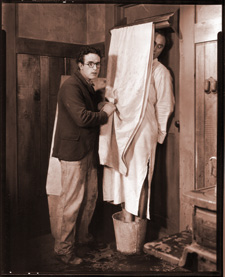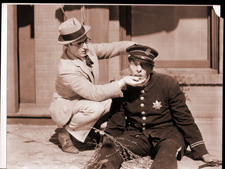By Annette D’Agostino Lloyd
Silent film has seen somewhat of a resurgence in popularity in recent years, with increased live theatrical screenings and greater visibility via such cable television channels as Turner Classic Movies, which hosts Silent Sunday Nights and airs pre-talkie pictures frequently during the week as well.
 It is widely known that, in the early days of television, Harold Lloyd was reluctant to allow his films to be shown in this medium, due to stricter time slots, choppy editing and commercial breaks which interrupt story flow. Lloyd felt, and rightly so, that his films need to be seen in their entirety, undisturbed and uncut. However, I feel (and if I might be so bold as to put words in the great man’s mouth) that Harold would wholly embrace cable TV, with its more comfortable scheduling, and its ability to show a film without interruption; for similar reasons, he’d love DVD. As such, I think he would be mighty happy about the way his films are being reintroduced to new generations. He would, no doubt, be thrilled that new audiences are finding out what Lloyd aficionados already know – my top three reasons why Harold Lloyd is important.
It is widely known that, in the early days of television, Harold Lloyd was reluctant to allow his films to be shown in this medium, due to stricter time slots, choppy editing and commercial breaks which interrupt story flow. Lloyd felt, and rightly so, that his films need to be seen in their entirety, undisturbed and uncut. However, I feel (and if I might be so bold as to put words in the great man’s mouth) that Harold would wholly embrace cable TV, with its more comfortable scheduling, and its ability to show a film without interruption; for similar reasons, he’d love DVD. As such, I think he would be mighty happy about the way his films are being reintroduced to new generations. He would, no doubt, be thrilled that new audiences are finding out what Lloyd aficionados already know – my top three reasons why Harold Lloyd is important.
His films are not as dated, and are still funny.
Comedy in the early part of the silent film era was very different than we know it today. In those days, primary comedy was found in the unusualness, the strangeness, and the quirk of characters – in short, the more unlike normal people you were, the funnier you were perceived to be. And, cinematic comics ran with that concept – even Harold Lloyd, once he established himself as a comic actor (note that, as an early stage actor, and even in his earliest film roles, Lloyd best liked serious, heavy and villainous roles, claiming that they “had more bite to them”). Harold’s first two main screen personas, Willie Work and Lonesome Luke, were as strange as could be, both in physical appearance and in situations, and especially in personality. Yet, even though he knew he was meeting the needs and demands of his audience, Lloyd was very dissatisfied with his gimmicky characterizations, and knew he could do better.
And do better he did: pioneering an entirely new kind of comedy – the humor to be found in the ordinary man – with his Glass Character, introduced in Over the Fence (1917). Now, after over two years of weekly Willie and Luke visitations with film audiences worldwide, Lloyd presented a Boy who wore normal clothes (not the overly tight or loose-fitting garb usually seen), boasted minimal makeup (no phony mustaches, chin pieces, triangular eyebrows, or pasty-faced foundation), and generally looked like a guy who could live down the street from anyone. The only “gimmick” Harold had to this character was a pair of lensless horn-rimmed glasses. “At a cost of seventy-five cents,” wrote Lloyd in his 1928 autobiography, “they provide a trademark recognized instantly wherever pictures are shown. They make low-comedy clothes unnecessary, permit enough romantic appeal to catch the feminine eye, usually averted from comedies, and they hold me down to no particular type of range of story.”
 More on that in a moment. However, in breaking from the norm, by revolutionizing comedy, by presenting a persona who was not engrained in his time, Lloyd created films that are not as dated as some others of his era. Sure, the cars in his films are of his time; the architecture, the furnishings, the situations scream of long ago – but Lloyd’s Glass Character, in looking like us, doesn’t instantly invoke thoughts of generations past. And, in so doing, his humor – the situations he found himself in, and his demeanor in facing them – is still funny. Which leads me to something Harold noted earlier …
More on that in a moment. However, in breaking from the norm, by revolutionizing comedy, by presenting a persona who was not engrained in his time, Lloyd created films that are not as dated as some others of his era. Sure, the cars in his films are of his time; the architecture, the furnishings, the situations scream of long ago – but Lloyd’s Glass Character, in looking like us, doesn’t instantly invoke thoughts of generations past. And, in so doing, his humor – the situations he found himself in, and his demeanor in facing them – is still funny. Which leads me to something Harold noted earlier …
The Glass Character changed with each film.
Lloyd mentioned how the Glass Character adhered to “…no particular type of range of story.” Sure: by looking like the common man, Harold was truly the rubber band of comedians, able to be stretched in numerous possible directions, easily, flawlessly, brilliantly.
In no period is this more visible than during the years in which Lloyd made his silent features, 1921-1928. With four years’ worth of Glass Character experience under his belt, in which he refined and perfected the comedy to be found in the everyman, Harold undertook a series of pictures which show why his Glass Character is one of the most ingenious and versatile personas ever screened. In the span of those 11 films, he changed with each release – in personality, in motivation, in style. And, in so doing, with each successive movie, he captured new audiences who could actually relate to a comedy character. Realistically speaking, this was revolutionary.
You see, on the whole, few of us know extreme poverty, social outcastness, and obvious physical unusualness; many of the situations presented in general silent film comedy have no real meaning to us – we could never be in most of the predicaments seen on the overall screen. (This is why a large segment of silent film comedy is no longer funny to us, and why some of what was silent film drama and tragedy conjures a chuckle in this day and age.) However, looking at the silent Lloyd features, we can see ourselves, running rampant, through one or more of his characterizations: rich loafer who finds himself by getting a job and saving his girlfriend (A Sailor-Made Man); shy coward who finds his inner strength need not be housed in a talisman (Grandma’s Boy); poor country doctor who inspires patients to find health through enthusiasm (Dr. Jack); young country boy in the big city going to extremes to impress his girl (Safety Last!); wealthy hypochondriac who finds that he’s only sick in his head (Why Worry?); shy boy who is cured of his stuttering and his cowardice by finding his first honest love (Girl Shy); henpecked husband who uses unusual methods to quiet his in-laws (Hot Water); college boy who finds his popularity through sport (The Freshman); pompous rich man who finds real riches through love (For Heaven’s Sake); the runt of a strong family flexing real muscle by saving his family from ruin (The Kid Brother), and flip city kid who becomes a man by saving NYC’s last horsecar (Speedy). Just think about what it must have been like for audiences of the 1920s, after years of watching comedy characters who were social and personal misanthropes, to finally see a humorous persona who actually reflected their lives! It is no wonder that Harold Lloyd was rewarded with popular and box office supremacy, winning scores of popularity polls, and earning more money in total than any of his contemporaries. Silent era audiences loved Lloyd … and his adaptability to each of our personalities and sensibilities makes him an enduring legend to this day.
The Lloyd films are supremely family-friendly.
I am the proud Mama of Matt, born in 2004, child of an era of popular culture that, frankly, holds much to be desired. I note this because, from infancy, Matt has been watching the films of Harold Lloyd (having a Mama who is his most vociferous biographer in this generation doesn’t hurt, either…). Our son asks to watch “Uncle Harold” and, even at his young age, laughs at what he sees. I chalk this up to one huge quality the Lloyd films boast: enthusiasm.
 It can be generally noted that most, if not all, of the Lloyd films (even most of the shorts, and the sound features as well) have keen optimism as their centerpiece. Harold Lloyd, in his Glass Characterizations, believes that he can overcome whatever obstacle is thrown his way, and faces adversity with fervor and passion. He smiles a lot; we like him, and on the whole, we can see why others like him too. He catches the gaze of females – for many women, he’s perceived as a good catch – his upbeat demeanor and confidence are inspiring. My husband (Scott Lloyd) once noted to me how Harold Lloyd embodied the type of man who he’d like to grow up to be: “I was never quite as optimistic, brave, courteous, funny, or courageous as Harold was in his films,” wrote Scott to me in 1997, “but he became an icon and was always a symbol of the type of person I wanted to be. A fundamental thing our society lacks today is a body of positive role models for young people. Harold was that role model for me and it affected my life deeply.”
It can be generally noted that most, if not all, of the Lloyd films (even most of the shorts, and the sound features as well) have keen optimism as their centerpiece. Harold Lloyd, in his Glass Characterizations, believes that he can overcome whatever obstacle is thrown his way, and faces adversity with fervor and passion. He smiles a lot; we like him, and on the whole, we can see why others like him too. He catches the gaze of females – for many women, he’s perceived as a good catch – his upbeat demeanor and confidence are inspiring. My husband (Scott Lloyd) once noted to me how Harold Lloyd embodied the type of man who he’d like to grow up to be: “I was never quite as optimistic, brave, courteous, funny, or courageous as Harold was in his films,” wrote Scott to me in 1997, “but he became an icon and was always a symbol of the type of person I wanted to be. A fundamental thing our society lacks today is a body of positive role models for young people. Harold was that role model for me and it affected my life deeply.”
What parent wouldn’t find comfort in classic films that actually present trusted role models? That is but one reason why I always encourage families to watch and enjoy the Lloyd films, either in theatres, on cable, or on DVD – parents will never be ashamed, embarrassed, puzzled, or bewildered by these wonderful pictures – they are golden family anchors.
I could go on and on (and on) about why Harold Lloyd (to coin a phrase) rocks my world. It pleases me immensely to be offering this sampling of my feelings to HaroldLloyd.com, the official website of the Harold Lloyd Estate and Film Trust. I am honored to have been asked to contribute, and encourage more contemporary scholars, critics, and fans to do the same, both here and at my neighboring website, HaroldLloyd.us. I honestly feel it is vital to continue to reintroduce Harold Lloyd to new generations, through exposure of his films, and critical reassessments of his work. And this can be done through HaroldLloyd.com and HaroldLloyd.us, which I like to think of as the Internet equivalent to Beverly Hills and Cannes: brother and sister sites, both trumpeting the same noble mission, that of sharing why, in his time and ours, Harold Lloyd is important.
